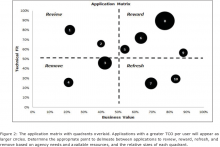2020 presents an exciting time for government CIOs. A new era, a new decade ripe for change. Deloitte recently released a list of nine technology trends transforming government, and one, in particular, will be key to enabling the future of technology in government: The cloud as an innovation driver.
While the cloud isn’t new to most agencies, it's often still used as a cost-cutting and efficiency measure. And while some agencies have certainly started to use the cloud as a strategic advantage to benefit their missions, Deloitte's prediction that more agencies will begin to realize cloud's full potential in 2020 is very exciting.
As I reflect on the progress I've seen in 2019, I believe the cloud absolutely has the potential to play a much more strategic role in government IT. Let's reflect on the progress government IT leaders made with the cloud this year.
[ What is multi-cloud? How does it differ from hybrid cloud? Read How to explain multi-cloud in plain English ]
From cloud first to cloud smart
The chart on page 50 of the Deloitte report gives you a sense of just how broad adoption is among governments around the world. While many federal, state, and local governments worldwide are now adopting a Cloud First strategy, the 2019 US Federal Cloud Computing Strategy has transitioned from Cloud First to Cloud Smart. In many ways, the new policy is catching up with the practical reality that not every application is well-suited for the cloud today.
As agencies progress in their cloud journey, they will live in a hybrid and multi-cloud world for years to come. To help accelerate government cloud adoption, the Office of Management and Budget (OMB), the Federal Chief Information Officers Council, and GSA collaborated to develop the Application Rationalization Playbook, a practical guide to assess applications and help agencies manage their IT portfolios. Instead of moving everything to the cloud, the policy recommends that portfolio managers review, reward, refresh, and remove applications as appropriate (see graphic below).

The most succinct cloud strategy I’ve heard in 2019 was from a senior federal IT leader who said, “All net new workloads are Cloud First. All existing workloads are Cloud Smart.”
Hybrid cloud and data gravity
Over the past few years, I’ve asked government IT leaders about their cloud exit strategies. At first, I'd get a lot of blank stares because the mindset was so fixed on a one-way superhighway to Cloud First. Fortunately, a few of the government cloud trailblazers actually did tell me early on that they had exit strategies. They had “been there, done that” with vendor lock-in and didn’t want to relive those experiences again. Vendor lock-in can be particularly acute in the public cloud because agencies no longer own the hardware that runs their applications, the storage where their data resides, or the rules on how to retrieve their data if they want to leave.
One government IT leader told me his agency’s strategy is to only use cloud-specific services that can be reproduced outside of that cloud if necessary. One example he cited is their use of Amazon RDS for MySQL. AWS maintains the MySQL servers and software so his staff doesn’t have to, and they can always move their application off of AWS and manage the MySQL servers themselves if needed.
[ Read more by Dave Egts: 3 ways to stop automation fear in government IT. ]
More government IT leaders began taking a closer look at cloud exit strategies this year after witnessing the aftermath of some cloud vendor selection processes, where contracts are being protested for a variety of reasons.
Data gravity is another area that is front-of-mind for government IT leaders. Data is being generated at an amazing rate. Former Intel CEO Brian Krzanich said in 2016 that one autonomous car would generate and consume roughly 4 TB of data for one hour’s driving a day. Sending this data to a public cloud for processing is impractical, if not impossible.
To address this problem, it’s much easier to send the compute to where the data are, as opposed to the other way around – and that’s where edge computing comes in. U.S. Air Force CTO Frank Konieczny recently addressed the application of edge computing to the Air Force mission head-on during a panel discussion we were on at the Federal Executive Forum. He expects to have mission capability “pushed to the edge” to micro-data centers and micro-clouds where the data is generated, including the aircraft and their depots. He also recommends that when modernizing applications, you should migrate groups of applications that communicate heavily between themselves to minimize latency and egress costs. Lastly, he’s not just focused on the hybrid cloud but also multi-cloud to ensure continuity of mission operations in case of a cloud outage.
A focus on cloud and people skills
Workforce concerns have consistently been a key concern with government IT leaders this year, and that will continue in 2020 and beyond. The Cloud Smart policy and the White House’s Executive Order on Maintaining American Leadership in Artificial Intelligence highlight the need for a skilled workforce. The Federal Cyber Reskilling Academy serves a dual purpose of retaining government talent while addressing talent shortages in government cybersecurity.
When I speak with government IT leaders about digital transformation, we discuss people, process, and technology. Every government IT leader I’ve spoken with has said technology is the easy part. The most challenging problems involve aligning employee skills and passions with the agency’s mission to create purpose while also creating processes that drive efficiency and innovation. They’re also the most rewarding problems to solve. I look forward to seeing the creative ways government IT leaders continue to take on these challenges in the year ahead.
[ Learn the do's and don'ts of multi-cloud. Get the free eBook, Multi-Cloud Portability for Dummies. ]




Comments
Great article indeed!Talent Management is a term that is being thrown around in the workplace, being used interchangeably with human capital management and employee management system but that is not correct. Each of these terms have key differences. To know more about what the differences are and learn about talent management on our latest blog https://blog.peoplehum.com/recruitment/talent-management-the-game-changer-in-business/#bl